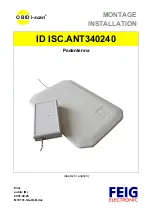
31
Operation
EATON TFX INSTALLATION AND OPERATION MANUAL
6046279-001
September 2019
www.eaton.com
5.4 File transfer
You can use the device to transfer files between the Data
platform and the machine’s
CANopen network.
5.4.1 File transfer
TRANSFERRING A FILE TO THE Data platform
A simple transfer of files up to 128 kByte via the CAN bus
to the Data platform is implemented in the device. The files
are saved in the device in an internal nonvolatile memory
and automatically transferred to the Data platform when a
server link is established.
The following steps are required for the transfer:
1. An external device transfers a file by CANopen
SDO protocol to the object 0x5421, 0x03 of the
CANlink mobile:
D
eviCe
v
ariaBles
> f
ile
t
ransfer
t
ransmit
- f
ile
D
ata
-
C
aCheD
m
oDe
2. An external device transfers the file name by
CANopen SDO protocol to the object 0x5420, 0x03 of
the TFX as a string in the format 8.3:
D
eviCe
v
ariaBles
> f
ile
t
ransfer
t
ransmit
- f
ilename
-
C
aCheD
m
oDe
3. An external device writes the value 1 to the object
0x5422, 0x03 of the CANlink mobile. This triggers
automatic file transfer to the Data platform:
D
eviCe
v
ariaBles
> f
ile
t
ransfer
t
ransmit
- C
ommanD
-
C
aCheD
m
oDe
You can find out the current available free memory space
using the object 0x5423, 0x04 (
D
eviCe
v
ariaBles
> f
ile
t
ransfer
t
ransmit
- g
et
free
s
paCe
- C
aCheD
m
oDe
). As long
as memory space is available, several files can be logged in
the device. The files are then automatically transmitted to
the Data platform in the order in which they were written to
the device.
For detailed information on creating objects, see chapter
Creating object dictionary groups and objects.
READING A FILE TRANSFERRED BY PROEMION
PROEMION can transfer files in segments of 1024 bytes
each via the device. The files transferred by the Data
platform are saved to a CANopen control unit in the device
in an internal, volatile memory. They can be read off from
the device by the CANopen network.
To be able to read off files transferred to the Data platform,
you need to take the following steps.
1. Check that the object 0x5402 Sub-Index 0 has the
value 01. This value indicates that PROEMION has
transferred a file to the device.
f
ile
t
ransfer
r
eCeive
- i
nDiCation
2. If the object has the value 01, you can read the file
name from the object 0x5400 Sub-Index 0.
f
ile
t
ransfer
r
eCeive
- f
ilename
3. Read off the file from the object 0x5401 Sub-Index 0.
f
ile
t
ransfer
r
eCeive
- f
ile
4. When the file has been read off, write the value 0 in
the object 0x5402 Sub-Index 0.
f
ile
t
ransfer
r
eCeive
- i
nDiCation
3
3
The device is then ready to receive a new file from
the Data platform.
For detailed information on creating objects, see chapter
Creating object dictionary groups and objects.
5.4.2 File transfer restrictions
Restrictions apply to file transfer.
The following conditions must be met:
> The file names must have 8 characters and the file
extension must have 3 characters (8.3 format).
> Characters permitted for the file name and file extension
are “A” … “Z”, “a” … “z” and “0” … “9”.
If these conditions are not met, the device and/or the Data
platform will reject the file. This blocks transmission in both
directions. To cancel the block, you must delete the faulty
file from the Data platform or from the file transfer.
5.5 Encrypted data transfer
The device supports encrypted data transfer to the Data
platform according to the TLS standard (Transport Layer
Security).
Encrypted data transfer is already enabled when the device
is delivered.
The variables required belong to the DEVICE VARIABLES
object dictionary group.
Table 29: Encrypted data transfer
Variable
Function
e
naBle
enCrypteD
Data
transfer
0 = disable encrypted data transfer
1 = enable encrypted data transfer
r
emote
s
erver
p
ort
61200 = port for encrypted data transfer
60200 = port for unencrypted data transfer
NOTICE
Encrypted data transfer is banned in some countries.
Please observe local regulations on encrypted data transfer.
INFORMATION
After a device reset to factory settings, encrypted data
transfer is enabled as standard.
5.6 Important device variables
This chapter gives you information on important device
variables that control the device functions.
















































